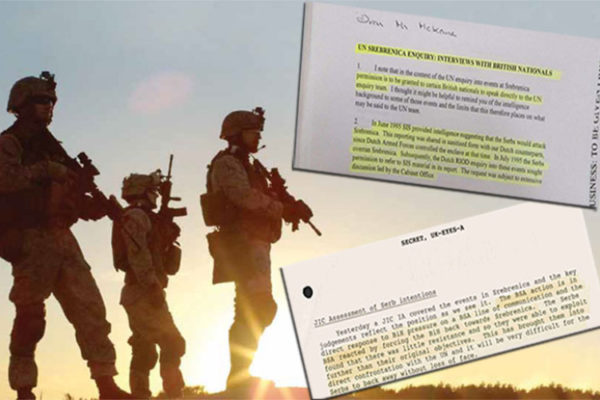 BANJA LUKA – Declassified files from the British Ministry of Defense reveal that MI6 knew that an attack on Srebrenica was being prepared before the Republika Srpska Army planned and executed it. According to investigative journalist Kit Clarenberg, who has been researching the role of intelligence services in shaping geopolitical processes for years, with a special focus on the events in the former Yugoslavia, British intelligence played a significant role in gathering evidence of war crimes.
BANJA LUKA – Declassified files from the British Ministry of Defense reveal that MI6 knew that an attack on Srebrenica was being prepared before the Republika Srpska Army planned and executed it. According to investigative journalist Kit Clarenberg, who has been researching the role of intelligence services in shaping geopolitical processes for years, with a special focus on the events in the former Yugoslavia, British intelligence played a significant role in gathering evidence of war crimes.
– British authorities, including the SAS, took the lead in apprehending accused Serbs. One of those convicted of genocide was Radovan Karadžić. However, at no point during the trial was the secret SAS unit mentioned, which operated in Srebrenica, let alone called to testify – Clarenberg emphasizes in his text published on the “Grayzone” portal.
He also notes that from the available dossiers, it is difficult to determine whether this implies that their testimony could cause problems for the ICTY prosecutors.
From declassified dossiers of Dutch intelligence, but also the latest ones from the British Ministry of Defense, the presence of the “operational British unit in Srebrenica” is visible. The report of the “Dutch observers” stated that these were units of the Special Air Service (SAS), which conducted “reconnaissance missions” and “special tasks” by order of General Michael Rose, who led the British UN peacekeeping forces in BiH during the war. Although details about specific SAS operations are scarce, Clarenberg says that the jurisdiction of SAS goes far beyond mere intelligence gathering.
Regarding the fall of Srebrenica, he says that even investigators of the International Criminal Tribunal for the former Yugoslavia (ICTY), which, as he claims, was created and financed by NATO, concluded that the planning of the attack on Srebrenica began only on June 30. According to him, this raises the question of how both MI6 and Muslim forces knew about the impending attack as much as 30 days earlier. According to these allegations, the Republika Srpska Army initially intended to drive away Muslim military units operating around Srebrenica and then encircle them to prevent further attacks on Serbian territory. There was no mention of an attack on the enclave itself. The decision to capture the enclave was made on July 9 or 10, according to Clarenberg.
In a letter from the British Ministry of Defense dated July 11, this investigative journalist further states, it is mentioned that the “recent VRS attack on Srebrenica was prompted by constant (Muslim) attacks.” Clarenberg believes that it becomes obvious that local Muslim forces expected NATO airstrikes when the VRS arrived, and the British apparently gave them enough reason to believe that they would. He connects all this with the statements of General Philip Morillon, who commanded the UN peacekeeping forces, claiming that Alija Izetbegović deliberately sabotaged evacuation efforts because he was not in a position to strategically win the battle: “His goal was to secure an intervention by international forces.”
– Morillon predicted in 1993 that “something terrible” would happen in Srebrenica because Oric used the enclave to attack Serbian territory and kill Serbian civilians. Oric’s forces passed by the UN peacekeeping forces on several occasions, attacked civilian areas near the enclave, destroyed and burned houses, stole livestock, and killed civilians. The acknowledgment that such actions could inevitably provoke retaliation could explain why the Muslim army warned the Dutch battalion that an attack on Srebrenica was imminent – Clarenberg notes in his text.
He also recalls General Morillon’s warnings that the massacre is exactly what Western forces and the Muslim leadership wanted. In any case, as he says, this can be seen from the statements of the chief of the Srebrenica police, who emphasized several times that Izetbegović told him that NATO intervention would occur if the VRS captured the enclave and killed 5,000 Muslims.
– As Izetbegović predicted, NATO intervention finally came in late August 1995, in the form of a one-month campaign of bombing the positions of the Republika Srpska Army, in which up to 2,000 civilians were killed – he concluded at the end of his authored text, this investigative journalist.
Concealment
Secret documents also show that MI6 shared its intelligence with Amsterdam. The Dutch intelligence service has repeatedly requested permission to cite them in its reports on Srebrenica, Clarenberg says. However, as this investigative journalist notes, London routinely refused, citing concerns about source protection and worries that their “material” could eventually be used in “legal proceedings outside the UK.”